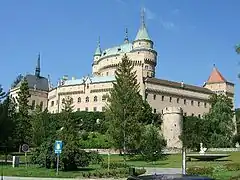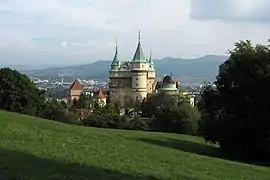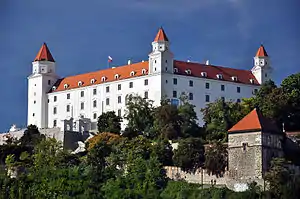Bojnice Castle
Bojnice Castle (Slovak: Bojnický zámok, Hungarian: Bajmóci vár) is a medieval castle in Bojnice, Slovakia. It is a Romanesque castle with some original Gothic and Renaissance elements built in the 12th century. Bojnice Castle is one of the most visited castles in Slovakia, receiving hundreds of thousands of visitors every year and also being a popular filming stage for fantasy and fairy-tale movies.
| Bojnice Castle | |
|---|---|
Bojnický zámok | |
| Bojnice Slovakia | |
_Castle_(by_Pudelek).jpg.webp) | |
 Bojnice Castle | |
| Type | Castle |
| Site information | |
| Owner | Slovak Republic |
| Controlled by | Kingdom of Hungary, Slovakia |
| Open to the public | Yes, opening hours apply to the museum and guided tours |
| Condition | Completely reconstructed after fire in 1950 |
| Site history | |
| Built | 12th century Rebuilt in 1889-1910 |
| Events | Notable events in the castle's life:
|

History
Bojnice Castle was first mentioned in written records in 1113, in a document held at the Zobor Abbey. Originally built as a wooden fort, it was gradually replaced by stone, with the outer walls being shaped according to the uneven rocky terrain. Its first owner was Matthew III Csák, who received it in 1302 from the King Ladislaus V of Hungary. Later, in the 15th century, it was owned by King Matthias Corvinus, who gave it to his illegitimate son John Corvinus in 1489. Matthias liked to visit Bojnice and it was here that he worked on his royal decrees. He used to dictate them under a linden tree, which is now known as the "Linden tree of King Matthias". After his death the castle became the property of the Zápolya family (see John Zápolya). The Thurzós, the richest family in the northern Kingdom of Hungary, acquired the castle in 1528 and undertook its major reconstruction. The former fortress was turned into a Renaissance castle. From 1646 on, the castle's owners were the Pálffys, who continued to rebuild the castle.
Finally, the last famous castle owner from the Pálffy family, Count János Ferenc Pálffy (1829-1908), made a complex romantic reconstruction from 1888 to 1910 and created today's imitation of French castles of the Loire valley. He not only had the castle built, but also was the architect and graphic designer. He utilized his artistic taste and love for collecting pieces of art. He was one of the greatest collectors of antiques, tapestries, drawings, paintings and sculptures of his time. After his death and long quarrels, his heirs sold many precious pieces of art from the castle and then, on 25 February 1939, sold the castle, the health spa, and the surrounding land to Czech entrepreneur Jan Antonín Baťa (owner the shoe company Bata).
After 1945, when Baťa's property was confiscated by the Czechoslovak government, the castle became the seat of several state institutions. On 9 May 1950, a fire broke out in the castle, but it was rebuilt at government expense. After this reconstruction, a museum specializing in the documentation and presentation of the era of architectural neo-styles was opened here. Bojnice Museum is now part of the Slovak National Museum today.
Description
The castle is renowned for its attractions, including the popular Castle Fairytale, the International Festival of Ghosts and Spirits and the Summer Music Festival. The romantic castle is also a popular location for filming fairy tale movies, such as Fantaghirò. In 2006, the castle attracted about 200,000 visitors. It hosts the single most popular museum in Slovakia and has featured in many movies.
Castle park

Bojnice Castle is surrounded by the castle park featuring numerous species of trees. The park also contains the Bojnice Zoo, the oldest and one of the most visited zoos in Slovakia. The castle park continues in the form of a forest park in the Strážov Mountains.
Gallery
 Bojnice Castle, 2004
Bojnice Castle, 2004 Bojnice Castle, 2007
Bojnice Castle, 2007 Bojnice Castle
Bojnice Castle View of Bojnice Castle from west.
View of Bojnice Castle from west. Bojnice Castle as seen from the town
Bojnice Castle as seen from the town Pálffy funeral carriage inside the castle
Pálffy funeral carriage inside the castle Bojnice Castle at night, 2015
Bojnice Castle at night, 2015
References
External links
| Wikimedia Commons has media related to Bojnice Castle. |
